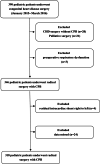Post-cardiopulmonary bypass hypoxaemia in paediatric patients undergoing congenital heart disease surgery: risk factors, features, and postoperative pulmonary complications
- PMID: 36180821
- PMCID: PMC9523995
- DOI: 10.1186/s12872-022-02838-9
Post-cardiopulmonary bypass hypoxaemia in paediatric patients undergoing congenital heart disease surgery: risk factors, features, and postoperative pulmonary complications
Abstract
Background: Hypoxemia after cardiopulmonary bypass (CPB) is the quantifiable manifestation of pulmonary dysfunction. This retrospective study was designed to investigate the risk factors for post-cardiopulmonary bypass hypoxaemia and the features of hypoxaemia and pulmonary complications in paediatric congenital heart disease surgery involving CPB.
Methods: Data including demographics, preoperative pulmonary or cardiac parameters, and intraoperative interventions were retrospectively collected from 318 paediatric patients who underwent radical surgery with CPB for congenital heart disease. Among them, the factors that were significant by univariate analysis were screened for multivariate Cox regression. The lowest ratio of arterial oxygen tension and the inspiratory oxygen fraction (PaO2/FiO2), hypoxaemia (PaO2/FiO2 ≤ 300) insult time, duration of hypoxaemia, extubation time, and pulmonary complications were also analysed postoperatively.
Results: The morbidity of post-cardiopulmonary bypass hypoxaemia was 48.4% (154/318). Months (6 < months ≤ 12, 12 < months ≤ 36 and 36 < months compared with 0 ≤ months ≤ 6: HR 0.582, 95% CI 0.388-0.873; HR 0.398, 95% CI 0.251-0.632; HR 0.336, 95% CI 0.197-0.574, respectively; p < 0.01), preoperative intracardiac right-to-left shunting (HR 1.729, 95% CI 1.200-2.493, p = 0.003) and intraoperative pleural cavity entry (HR 1.582, 95% CI 1.128-2.219, p = 0.008) were identified as independent risk factors for the development of post-cardiopulmonary bypass hypoxaemia. Most hypoxaemia cases (83.8%, 129/154) occurred within 2 h, and the rate of moderate hypoxaemia (100 < PaO2/FiO2 ≤ 200) was 60.4% (93/154).
Conclusion: The morbidity of post-cardiopulmonary bypass hypoxaemia in paediatric congenital heart disease surgery was considerably high. Most hypoxaemia cases were moderate and occurred in the early period after CPB. Scrupulous management should be employed for younger infants or children with preoperative intracardiac right-to-left shunting or intraoperative pleural cavity entry.
Keywords: Cardiopulmonary bypass; Child; Complications; Congenital heart disease; Hypoxaemia.
© 2022. The Author(s).
Conflict of interest statement
The authors declare no competing interests.
Figures
Similar articles
-
Lung protective ventilation in infants undergoing cardiopulmonary bypass surgery for congenital heart disease: A prospective randomized controlled trial.Paediatr Anaesth. 2020 Jul;30(7):814-822. doi: 10.1111/pan.13894. Paediatr Anaesth. 2020. PMID: 32338441 Clinical Trial.
-
Postcardiopulmonary bypass hypoxemia: a prospective study on incidence, risk factors, and clinical significance.J Cardiothorac Vasc Anesth. 2000 Oct;14(5):506-13. doi: 10.1053/jcan.2000.9488. J Cardiothorac Vasc Anesth. 2000. PMID: 11052429
-
The Characterization of Postoperative Mechanical Respiratory Requirement in Neonates and Infants Undergoing Cardiac Surgery on Cardiopulmonary Bypass in a Single Tertiary Institution.J Cardiothorac Vasc Anesth. 2022 Jan;36(1):215-221. doi: 10.1053/j.jvca.2021.04.023. Epub 2021 Apr 25. J Cardiothorac Vasc Anesth. 2022. PMID: 34023203
-
Extracardiac Fontan operation without cardiopulmonary bypass.J Cardiovasc Surg (Torino). 2006 Dec;47(6):699-704. J Cardiovasc Surg (Torino). 2006. PMID: 17043618 Review.
-
Nonneurologic morbidity and profound hypothermia in aortic surgery.Ann Thorac Surg. 2004 Aug;78(2):596-601. doi: 10.1016/j.athoracsur.2004.01.012. Ann Thorac Surg. 2004. PMID: 15276529 Review.
Cited by
-
Effect of one-lung ventilation in children undergoing lateral thoracotomy cardiac surgery with cardiopulmonary bypass on postoperative atelectasis and postoperative pulmonary complications.BMC Pediatr. 2025 Apr 2;25(1):268. doi: 10.1186/s12887-025-05600-0. BMC Pediatr. 2025. PMID: 40175952 Free PMC article. Clinical Trial.
-
Comparison of high-flow nasal cannula oxygenation and non-invasive ventilation for postoperative pediatric cardiac surgery: a meta-analysis.BMC Pulm Med. 2024 Feb 21;24(1):92. doi: 10.1186/s12890-024-02901-5. BMC Pulm Med. 2024. PMID: 38383357 Free PMC article.
-
Molecular and Biochemical Mechanisms of Cardiomyopathy Development Following Prenatal Hypoxia-Focus on the NO System.Antioxidants (Basel). 2025 Jun 16;14(6):743. doi: 10.3390/antiox14060743. Antioxidants (Basel). 2025. PMID: 40563375 Free PMC article. Review.
References
MeSH terms
Substances
LinkOut - more resources
Full Text Sources
Medical



